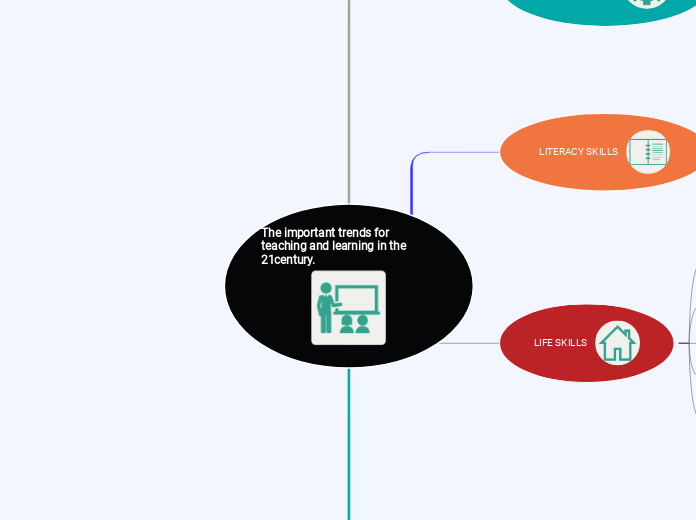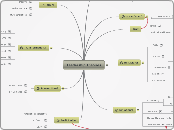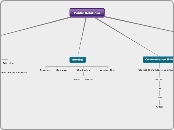The important trends for teaching and learning in the 21century.
The Solar System is the gravitationally bound system of the Sun and the objects that orbit it, either directly or indirectly. Of the objects that orbit the Sun directly, the largest are the eight planets, with the remainder being smaller objects, the dwarf planets, and small Solar System bodies.
BIBLIOGRAPHY
Uranus is an oddball. It has clouds made of hydrogen sulfide, the same chemical that makes rotten eggs smell so foul.
It rotates from east to west like Venus. Its tilt causes extreme seasons that last 20-plus years, and the sun beats down on one pole or the other for 84 Earth-years at a time.
Methane in the atmosphere gives Uranus its blue-green tint. It also has 13 sets of faint rings.
Zook, Chris. [21st Century Classroom]. (2019, May 24). What are 21st Century Skills? Recuperado de https://www.youtube.com/watch?v=QYfCEnTmr5o
Uranus has 27 moons that we know of. Five of the moons are large and the rest are much smaller.
Name these 5 moons.
Ruhl, Joe. [TEDx Talks]. (2015, Mayo 27). Teaching Methods for Inspiring the Students of the future. Recuperate de https://www.youtube.com/watch?v=UCFg9bcW7Bk
How long does it take for Uranus to go around the sun?
Kannan, J. A. (2018). New Trends in Second Language Learning and Teaching through the lens of ICT, Networked Learning, and Artificial Intelligence. Círculo de Lingüística Aplicada a la Comunicación. Obtenido de http://webs.ucm.es/info/circulo/no76/kannan.pdf
A planet's day is the time it takes the planet to rotate or spin once on its axis.
Write down Uranus's day measured in Earth days.
Gulcin Nagehan.S, Nadire. c. (December de 2009). New trends in 21st Century English learning. Procedia Social and Behavioral Sciences , 439-445. Obtenido de https://www.researchgate.net/publication/229395107_New_trends_in_21st_Century_English_learning
LIFE SKILLS
Mercury is the smallest, only a little bit larger than Earth's moon. Mercury has no moon.
It experiences dramatic changes in its day and night temperatures: Day temperatures can reach a scorching 840 F (450 C), which is hot enough to melt lead. Meanwhile, on the night side, temperatures drop to minus 290 F (minus 180 C).
It also has a very thin atmosphere of oxygen, sodium, hydrogen, helium, and potassium and can't break-up incoming meteors, so its surface is pockmarked with craters, just like the moon.
Social Skills
It is the set of behavioral strategies that help us to solve a social situation effectively. it also allows us to express the feelings, attitudes, opinions, etc. that are appropriate to the situation
Productivity
Productivity is the performance of maximum excellence
Initiative
How long does it take for Mercury to go around the sun?
An attitude with initiative allows to develop a great security and is an effort that helps to achieve the goals
Leadership
A planet's day is the time it takes the planet to rotate or spin once on its axis.
Write down Mercury's day measured in Earth days.
Is able to influence the way others act or think, motivating them to do tasks efficiently
Flexibility
It allows us to quickly adapt and tolerate changes that may occur during problem solving or task execution and they help us to generate alternatives.
LITERACY SKILLS
Neptune is about the size of Uranus and is known for supersonic strong winds.
Neptune is far out and cold.
The planet is more than 30 times as far from the sun as Earth.
Neptune was the first planet predicted to exist by using math, before it was visually detected. Neptune is about 17 times as massive as Earth and has a rocky core.
Technology Literacy
How long does it take for Neptune to go around the sun?
Students understand the machinery and equipment necessary i.e. computers, cell phones for the publication of information
Media Literacy
A planet's day is the time it takes the planet to rotate or spin once on its axis.
Write down Neptune's day measured in Earth days.
Is to understand the sources of information and whether it is reliable
Information Literacy
This skill is that the student reads something and understands what it really says, it can be a magazine article, blog, etc.
LEARNING SKILL
It was once considered a planet but in August 2006 the International Astronomical Union (IAU) downgraded the status of Pluto to that of “dwarf planet.”
Pluto is unlike other planets in many respects. It is smaller than Earth's moon; its orbit is highly elliptical.
It's a cold, rocky world with a tenuous atmosphere. Pluto is a very active ice world that's covered in glaciers, mountains of ice water, icy dunes, and possibly even cryovolcanoes that erupt icy lava made of water, methane or ammonia.
Collaboration
The dwarf planet Pluto has five moons.
Name these moons.
Collaboration is a complex process but it focuses on working together to achieve a goal, all of this is achieved with practice
Critical Thinking
A planet's day is the time it takes the planet to rotate or spin once on its axis.
Write down Pluto's day measured in Earth days.
Solve complex problems encountered in everyday life and have initiative to solve the problem
Communication
How long does it take for Pluto to go around the sun?
Communication is the easiest skill to practice and the most difficult to master. helps us to convey ideas quickly and accurately
Creativity
Our Solar System has eight “official” planets which orbit the Sun.
Each planet is at a different distance from the sun. Name its position.
Creativity can be applied in anything in life for example school, work and not only in art









